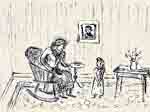
Fall 2005


|
|
 |
| Home | Index | Museums | Blog | Authors | Site Map | About |
|
About this IssueNote from the EditorsWe begin this issue with John H. Martin's book-length Saints, Sinners and Reformers: The Burned-Over District Re-visited. The pioneers who spread across the wide band of country running west from the Hudson River to Lake Erie sought to better themselves with richer and cheaper land, and to get away from old rigidities of privelege and custom. They were often confident free thinkers. Jack Martin describes the personalities and exploits of the outstanding, strong-willed and visionary men and women who opened land tracts for settlement, established communal societies, preached personal salvation, held psychic séances, sought equal rights for women and freedom from slavery for blacks, and promoted craftsmanship and personal perfection. Some of them claimed to have received supernatural visions; several of them had created a personal vision of an ideal society, others of a life without guilt and fear, and all perhaps urging personal improvement. There were those seeking riches from land speculation and through humbuggery. Richard Palmer of Syracuse finds interesting items pertaining to this early transportation in New York while culling through old newspapers and other sources, and begins a series here containing these early travel news reports. Dick contributes four separate pieces for this issue: the first installment of his Transportation Trivia series collecting early news items on public transportation; a description of the Camillus Erie Canal Park; a write-up of the Finger Lakes Railway; and "The Catskill Turnpike in Stage Coach and Tavern Days" by Lyman H. Gallagher from the Ithaca Journal-News, of Saturday Jan. 24, 1925. More from the Mendon - The Early Years series by John Sheret with his story of the "Clock System" rural index map for locating farms. The areas around rural towns were divided into segments numbered as the hours are on a clockface and into mile-wide concentric rings. Within each ring segment each farm was identified with a letter. A similar system used compass directions. Donovan Shilling tells us the story of Myron Holley who became an early active promotor of the Erie Canal, then a payroll agent during the construction of the canal, who was suddenly unable to account for $30,000. He was later forgiven this amount by the New York Legislature. Was the disappearance of these funds the means of insuring that the canal would go through Rochester? For a while he lived a quiet life growing vegetables for door-to-door sale and raising his 12 children. Later he became a forceful advocate of abolition, sold his farm and printed an anti-slavery paper in Rochester preceding Frederick Douglass. Grace Shults Fox's autobiography, A Tilted Saucer of Delight, continues in this issue with the beginning of Chapter Two relating her childhood and growing-up family experiences on their farm including excursions to nearby "Old Castle." More is to come of Grace Fox's eighty-one years as child, school girl, home maker, mother, teacher, poet, author, historian and neighbor on a farm inn upstate New York. Continuing Thomas D. Cornell's "Genesee Vignettes: Personal Reflections on the River through Rochester" are three more essays: Moving Further Upstream; A Day Trip Along the Upper Genesee; and Reaching Tom Territory. Photographs were taken by Tom. David Minor's New York Timeline for the year 1828, Part IV, contains four of his scripts relating the continued trip of Scotsman James Stuart and his wife across the state. The scripts are: #346, "Suddenly Taken;" #347, "When the Queen City Was a Pup"; #348, "Slowly They Turned"; and #349, "Top Down." Beth Flory has supplied the months of September, October and November for the years 1905 and 1955 in her "Glancing Backward" items from the Naples Record. Three more months, September, October, November, from Timothy Meigs Younglove's 1841 diary are in this issue from the transcription made by L. Paul Wood. Donovan Shilling, Chronicler for the New Society of the Genesee, contributes Exploring Cobblestone Country on the September 24, 2005, meeting in Childs and Albion, and Visiting the Historic Museums in Naples, New York about the meeting on October 15, 2005. CLR Blog | Site Map | Contact CLR |